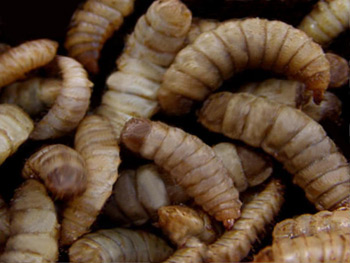Fattening maggots to create a designer food
A Broadcom MASTERS finalist wants to make fly larvae a sustainable human snack

Davia Allen (left) hangs out with science fans at the Broadcom MASTERS public presentation of projects in Washington, D.C.
E. Brady Robinson/SSP
WASHINGTON, D.C. — A fly larva looks like a fat wiggly worm. To most people, it doesn’t scream: Eat me! But to Davia Allen, 14, these maggots look like an opportunity. The ninth grader at Early County High School in Blakely, Ga., designed a science fair project to make fly larvae fat on the food wastes that people leave behind. She concluded that a cheap protein powder may pump up bugs the best.
Davia presented her project this week at Broadcom MASTERS. The competition brings 30 middle school students and their winning science fair projects here to show off the results of their work. MASTERS stands for Math, Applied Science, Technology and Engineering for Rising Stars. The competition was created by Society for Science & the Public (or SSP) and is sponsored by the Broadcom Foundation. SSP also publishes Science News for Students — and this blog.
People waste a lot of food. In the United States alone, up to 40 percent of edible food will eventually be thrown in the trash. Some of that waste spoiled in people’s kitchens. But a lot of it is thrown away before it ever reaches a grocery store or market. Some goes bad before it can be harvested. Other food is blemished and deemed too ugly for sale. Still more may spoil quickly, before it hits reaches a grocery shelf.

“I grew up in a farming town,” Davia notes. So she knew just how wasteful food production could be. That inspired her to find some way to reduce farm waste. While looking for a science project, the teen visited White Oak Pastures. It’s a farm in Bluffton, Ga. The owners have focused on sustainable practices. Their goal has been to use their land in ways that will keep it usuable in the future. Davia had planned on asking the farmers if they had an idea for her school project.
But then she learned the farmers were doing research with black soldier flies (Hermetia illucens). The adult flies don’t eat. No surprise, there. They don’t even have mouths! But their larvae eat organic wastes, such as fruits and vegetables. So the farmers were looking to offer those flies any of their fruits and veggies that were unsuitable for sale. Davia decided she would try the same thing, but at home.
The teen set out to feed up some larvae and find out which diet could produce the biggest bugs.
Using protein to pump up baby bugs
Black solider fly larvae start out very small. A female will lay about 500 eggs, each a mere 1 millimeter (0.04 inch) long. From hatching, the larvae start eating. And growing. “They can get rather large if you feed them the right things,” Davis learned. The larvae can grow to 27 millimeters (or 1.1 inches) long over 14 days. Then, they harden and become pupae for another two weeks before they finally reach adulthood.
Those big larvae are more than 40 percent protein by mass. This could make them a nutritious food for chickens, fish or people. Davia decided to see what she could do to make them an even better food. She decided to offer them extra protein so that they might grow even bigger.
The teen purchased black soldier fly eggs online. Then she counted out 3,000 of them. She placed 250 eggs into each of 12 plastic bins. When the eggs hatched, she began feeding the larvae.
Three bins got produce that grocery stores had deemed too ugly to sell. These included things like bumpy apples, brown lettuce and weird-shaped carrots. Three more bins got fruit and vegetables as well as a bonus — soybeans finely ground to make a flour. Another three bins got the fruits and veggies and peanuts ground into flour. A final three bins got fruits and veggies and flour made from a grain called quinoa. All three flours are high in protein. Davia wanted to see if any or all of these would boost larval growth.
To measure their growth, Davia fed and weighed her larvae in each bin five times over the course of a month. She also kept a count of how many fly larvae wiggled their way out of their bins or died.
The teen stored her project in her dad’s woodworking shop. “He cleared out an area and he just had to deal,” with both the smell (which was awful, Davia notes), and any loud, buzzing escapees.
After a month of feeding, weighing and cleaning, Davia compared the size of the larvae in each bin. Each bin started out with larvae that weighed around 7 grams (0.25 ounce) all together. By the end, the control larvae — those that got only fruits and vegetables with no extra protein — grew to almost 35 grams (1.2 ounces). Larvae eating food enriched with soy flour fed grew the most. They weighed in at just under 55 grams (1.9 ounces). The quinoa-flour enriched bins averaged 51 grams (1.7 ounces) and the peanut flour group averaged a mere 20 grams (0.7 ounce). The peanut group gained a lot of weight at first, Davia says. But peanut flour absorbs a lot of water, and black soldier fly larvae don’t like to get wet. So she ended up with a lot of runaways.
“Soy flour seems to hold the most promise for increasing larvae size while maintaining larvae health,” Davia concludes. It also would be the cheapest option. The teen bought all of her flours from the grocery store or online. Ten grams (0.35 ounce) of soy flour cost only 6 cents. The same amount of peanut flour cost 15 cents and quinoa flour 12 cents.
But even if black soldier fly larvae are nutritious, do they taste good? At the end of her experiment, Davia gave her larvae to a friend. He fed the bugs to his chickens, which gobbled them right up. Plenty of people around the world happily snack on insect larvae. Davia, however, has yet to sample any of hers (though she has looked up recipes on the internet about how to prepare them). For now, still just wants to boost awareness that black soldier fly larvae could covert food waste into something potentially snackable.
Follow Eureka! Lab on Twitter







